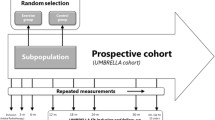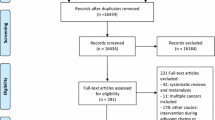Abstract
Purpose
The Exercise for Health trials were randomised, controlled trials designed to evaluate an 8-month pragmatic exercise intervention, commencing 6 weeks post-surgery for women with newly diagnosed breast cancer residing in urban or rural/regional Australia. For these exploratory analyses, the primary and secondary outcomes were overall survival (OS) and disease-free survival (DFS), respectively.
Methods
Consenting urban- (n = 194) and rural/regional-residing women (n = 143) were randomised to exercise (intervention delivered face-to-face or by telephone) or usual care. Cox proportional hazards models were used to estimate hazard ratios (HRs) and 95% confidence intervals (CI) for survival outcomes (exercise group, n = 207, 65% urban women; usual care group, n = 130, 46% urban women).
Results
After a median follow-up of 8.3 years, there were 11 (5.3%) deaths in the exercise group compared with 15 (11.5%) deaths in the usual care group (OS HR for the exercise group: 0.45, 95% CI 0.20–0.96; p = 0.04). DFS events for the exercise versus usual care group were 25 (12.1%) and 23 (17.7%), respectively (HR: 0.66, 95% CI 0.38–1.17; p = 0.16). HRs for OS favoured exercise irrespective of age, body mass index, stage of disease, intervention compliance, and physical activity levels at 12 months post-diagnosis, although were stronger (p < 0.05) for younger women, women with stage II + disease, women with 1 + comorbidity at time of diagnosis, higher intervention compliance and for those who met national physical activity guidelines at 12 months post-diagnosis.
Conclusion
An exercise intervention delivered during and beyond treatment for breast cancer, and that was designed to cater for all women irrespective of place of residence and access to health services, has clear potential to benefit survival. Trial numbers: ACT RN: 012606000233527; ACT RN: 12609000809235.




Similar content being viewed by others
Change history
10 November 2017
In the original publication of the article, under the heading Discussion, 1st paragraph, the sentence that reads as, “Nonetheless, our observed improvements of over 50% for OS and over 30% for DFS (HRs: 0.45 and 0.66, respectively) are consistent with results from other available studies” should read as “Nonetheless, our observed improvements of over 50% for OS and DFS (HRs: 0.45 and 0.66, respectively) are consistent with results from other available studies.” Under the heading Discussion, 3rd paragraph, the sentence that reads as “We cannot discount the possibility …such as education, income and access to care [1, 7]” should read as “We cannot discount the possibility…such as education, income and access to care, which ultimately have on survival outcomes [1, 7].”
References
Australian Institute of Health and Welfare (2016) Australia’s health 2016. In: Australia’s Health No. 15. AIHW, Canberra
Australian Institute of Health and Welfare (2012) Breast cancer in Australia: an overview. In: Cancer Series No. 71. AIHW, Canberra
Australian Institute of Health and Welfare (2015) Breast cancer in young women: key facts about breast cancer in women in their 20s and 30s. In: Cancer Series No. 96. AIHW, Canberra
Australian Institute of Health and Welfare (2004) Rural, regional and remote health: a guide to remoteness classifications. In: Rural Health Series No. 4. AIHW, Canberra
Cormie P, Zopf EM, Zhang X, Schmitz KH (2017) The impact of exercise on cancer mortality, recurrence, and treatment-related adverse effects. Epidemiol Rev 39:71–92. doi:10.1093/epirev/mxx007
Courneya KS, Segal RJ, McKenzie DC, Dong H, Gelmon K, Friedenreich CM, Yasui Y, Reid RD, Crawford JJ, Mackey JR (2014) Effects of exercise during adjuvant chemotherapy on breast cancer outcomes. Med Sci Sports Exerc 46:1744–1751. doi:10.1249/MSS.0000000000000297
Dasgupta P, Baade PD, Aitken JF, Turrell G (2012) Multilevel determinants of breast cancer survival: association with geographic remoteness and area-level socioeconomic disadvantage. Breast Cancer Res Treat 132:701–710. doi:10.1007/s10549-011-1899-y
Eakin EG, Lawler SP, Winkler EA, Hayes SC (2012) A randomized trial of a telephone-delivered exercise intervention for non-urban dwelling women newly diagnosed with breast cancer: exercise for health. Ann Behav Med 43:229–238. doi:10.1007/s12160-011-9324-7
Gordon LG, DiSipio T, Battistutta D, Yates P, Bashford J, Pyke C, Eakin E, Hayes SC (2017) Cost-effectiveness of a pragmatic exercise intervention for women with breast cancer: results from a randomized controlled trial. Psychooncology 26:649–655. doi:10.1002/pon.4201
Hayes S, Rye S, Battistutta D, Yates P, Pyke C, Bashford J, Eakin E (2011) Design and implementation of the Exercise for Health trial—a pragmatic exercise intervention for women with breast cancer. Contemp Clin Trials 32:577–585. doi:10.1016/j.cct.2011.03.015
Hayes SC, Rye S, Disipio T, Yates P, Bashford J, Pyke C, Saunders C, Battistutta D, Eakin E (2013) Exercise for health: a randomized, controlled trial evaluating the impact of a pragmatic, translational exercise intervention on the quality of life, function and treatment-related side effects following breast cancer. Breast Cancer Res Treat 137:175–186. doi:10.1007/s10549-012-2331-y
Ibrahim EM, Al-Homaidh A (2011) Physical activity and survival after breast cancer diagnosis: meta-analysis of published studies. Med Oncol 28:753–765. doi:10.1007/s12032-010-9536-x
Lahart IM, Metsios GS, Nevill AM, Carmichael AR (2015) Physical activity, risk of death and recurrence in breast cancer survivors: a systematic review and meta-analysis of epidemiological studies. Acta Oncol 54:635–654. doi:10.3109/0284186X.2014.998275
Pedersen BK, Saltin B (2015) Exercise as medicine—evidence for prescribing exercise as therapy in 26 different chronic diseases. Scand J Med Sci Sports 25(Suppl 3):1–72. doi:10.1111/sms.12581
Schemper M, Smith TL (1996) A note on quantifying follow-up in studies of failure time. Control Clin Trials 17:343–346
Schmitz KH, Courneya KS, Matthews C, Demark-Wahnefried W, Galvao DA, Pinto BM, Irwin ML, Wolin KY, Segal RJ, Lucia A, Schneider CM, von Gruenigen VE, Schwartz AL (2010) American College of Sports Medicine roundtable on exercise guidelines for cancer survivors. Med Sci Sports Exerc 42:1409–1426. doi:10.1249/MSS.0b013e3181e0c112
Therneau T (2015) A Package for Survival Analysis in S Version 2.38. https://CRAN.R-project.org/package=survival
Youlden D, Cramb S, Baade P (2009) Current status of female breast cancer in Queensland: Brisbane 1982 to 2006. In: Viertel Centre for Research in Cancer Control, Cancer Council Queensland, Brisbane
Acknowledgements
Study investigators would like to acknowledge and thank those who agreed to participate in the Exercise for Health trials. Their contributions to improving future breast cancer care are significant. Thank you also to the breast care nurses, exercise physiologists and research staff, in particular Sheree Rye and Tracey DiSipio, for their efforts in study recruitment, implementation and analysis, and to Emeritus Professor Beth Newman, who has provided invaluable review of this manuscript and mentorship throughout all phases of these trials.
Funding
The EfH urban and rural/regional trials were supported by two National Breast Cancer Foundation (NBCF) project grants. During the conduct of the EfH trials, SH and EE were supported by NBCF and National Health and Medical Research Council (NHMRC) research fellowships, respectively. SH is currently supported by a Cancer Council Queensland Fellowship.
Author information
Authors and Affiliations
Corresponding author
Ethics declarations
Conflict of interest
The authors declare that they have no conflict of interest.
Informed consent
Informed consent was obtained from all individual participants included in the study.
Ethical approval
All procedures performed in studies involving human participants were in accordance with the ethical standards of the institutional and/or national research committee and with the 1964 Helsinki declaration and its later amendments or comparable ethical standards.
Additional information
A correction to this article is available online at https://doi.org/10.1007/s10549-017-4569-x.
Electronic supplementary material
Below is the link to the electronic supplementary material.
Rights and permissions
About this article
Cite this article
Hayes, S.C., Steele, M.L., Spence, R.R. et al. Exercise following breast cancer: exploratory survival analyses of two randomised, controlled trials. Breast Cancer Res Treat 167, 505–514 (2018). https://doi.org/10.1007/s10549-017-4541-9
Received:
Accepted:
Published:
Issue Date:
DOI: https://doi.org/10.1007/s10549-017-4541-9




